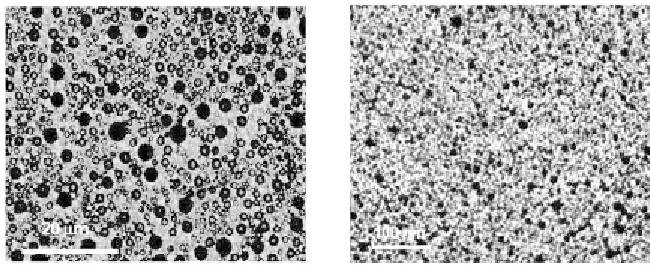Biomedical Engineering Reference
In-Depth Information
9.13.1 Principle
It has been found that flexible, elastomer micromembranes could be used in micro-
systems to separate a biofluid from another fluid or gas. Increasing the pressure (by
acoustic waves for example) or the temperature of the auxiliary fluid results in the
pressurization or agitation of the biofluid [29].
Another actuation of elastomer micromembranes can be achieved if the mem-
brane has magnetic elements attached to or embedded in it. Magnetic actuation
has been obtained first by fixing permalloy microplates to an elastomer micromem-
brane [30]; more recently, magnetic microparticles have been embedded in a PDMS
(poly-di-methyl-siloxane) matrix to obtain biocompatible, smooth-surfaced, and
totally deformable magnetic micromembranes [31].
The principle is to mix paramagnetic (carbonyl iron) or ferromagnetic (ferrite)
nanoparticles with liquid PDMS in a mass ratio of 25% to 50%. This matrix is
spread by spin-coating and left to polymerize. Very uniform membranes can be
obtained (Figure 9.38). An interesting property is that such membranes are nearly
as deformable and flexible as pure PDMS membranes. Deflection of membranes is
governed by two numbers: Young modulus (usually noted
E
and expressed in Pas-
cals) and Poisson coefficient (usually noted
n
and without unity). Young modulus
and Poisson coefficient for 100-
μ
m thick PDMS only membrane are of the order of
8.0 10
5
Pa and 0.5, whereas that of PDMS membrane containing carbonyl iron in
a mass ratio of 25% are of the order of 9.5 10
5
Pa and 0.55.
9.13.2 Deflection of Paramagnetic Micromembranes
Suppose now a circular paramagnetic micromembrane with a radius of 500- and
50-
μ
m thick; this membrane is clamped to a solid wall by its circular edge (Figure
9.39).
An estimate of the deflection of such membranes can be done by using the lin-
ear theory: if the maximum deflection is less than about 0.2 times the membrane
thickness [32]
h
w
£
(9.52)
maw
5
Figure 9.38
Two types of paramagnetic membranes. Left:
4
μ
m nanograins of carbonyl iron em-
bedded in PDMS. Right:10-nm nanograins extracted from ferrofluid embedded in PDMS.


